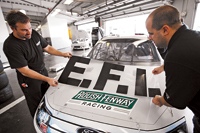NASCAR and EFI
NASCAR and EFI
 Carburetors Were Swapped for Throttle Bodies in 2012
Carburetors Were Swapped for Throttle Bodies in 2012
Motor Age — The Daytona 500 is arguably the most famous race on Earth. It marks the first entry into the NASCAR history books, when the first race sanctioned by the newly formed National Association for Stock Car Racing was held on the beach course on Feb. 15, 1948.
NASCAR’s history has its roots in the Prohibition era. Runners, the guys who moved homemade hooch, also fondly known as moonshine, hotrodded their cars so they could evade the federal agents that were trying to stop the illegal transport. Remember Burt Reynolds’ portrayal of the character “Gator McKlusky”? The runners built their reputations on their ability to outsmart, and outdrive, the law — and often held informal races to see who among them was the fastest.
By the end of the 1940s, these contests had become a roughly organized sport, largely due to the efforts of Bill France Sr. His work resulted in the birth of NASCAR on Dec. 14, 1947.
This year at the 2012 running of the Daytona 500, another entry was made into both the NASCAR and Daytona history books as fans witnessed the end of the carbureted engine, and the debut of electronic fuel injection (EFI) in the Cup series. Motor Age recently interviewed NASCAR Manager of R&D Mike Fisher about the change.
Source: Motor Age

